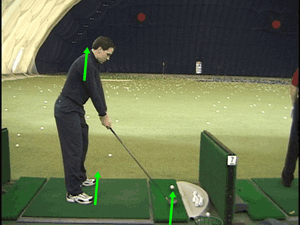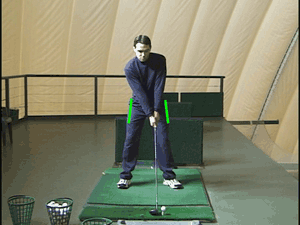4th visit

Here is the improvement compared to the last visit. The green lines (which are all parallel even if the illusion makes us believe that they are not) indicate the direction of the alignment. We can see that the shoulders, hips and feet are aligned and now the club follows indeed that line behind the ball. The chin is raised, allowing the shoulders to rotate right.

Now this is what we worked on during this visit. There is a saying "The more you minimize unnecessary movements, the more you decrease the chances of making mistakes." For example, if your front foot goes up during the rise of the swing, you reduce the chances that the foot will be placed at the right place and solid at impact. If the head moves a lot, you reduce the chances that it is at the right place at impact and the eyes watching the ball. The less you do useless moves, the greater your chances.
A common fault among amateur golfers is the presence of lateral displacement "sway" in the swing. This is a backward movement and then forwards the hips during the swing. This can cause a lot of problems with coordination at impact. This also causes the golfer to be more "lazy" and less rotating the hips and shoulders. In the image above, I have drawn two green lines at the hips. We can see on the next picture, the position of the hips relative to the two green lines.

This is the image stopped at the highest position in the backswing. Look at the hips that moved from their point of origin. The hips should normally rotate on themselves and work with the legs. Hips moving to the right cause loss of flexion at the knee. Leg becomes tensioned. Normally, hips that swivel on itself have the effect of lightly move the knee of the left leg forward to compensate for the rotation. I have given exercises to practice before the next visit to prevent the movement of the hips.
